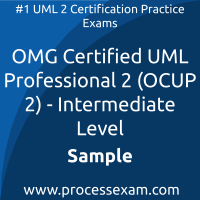 You have to pass the OMG-OCUP2-INT200 exam to receive the certification from OMG. To increase the effectiveness of your study and make you familiar with the actual exam pattern, we have prepared this OMG OCUP 2 Intermediate sample questions. Our Sample OMG Certified UML Professional 2 - Intermediate Practice Exam will give you more insight about both the type and the difficulty level of the questions on the OMG UML 2 Intermediate exam.
You have to pass the OMG-OCUP2-INT200 exam to receive the certification from OMG. To increase the effectiveness of your study and make you familiar with the actual exam pattern, we have prepared this OMG OCUP 2 Intermediate sample questions. Our Sample OMG Certified UML Professional 2 - Intermediate Practice Exam will give you more insight about both the type and the difficulty level of the questions on the OMG UML 2 Intermediate exam.
However, we are strongly recommending practice with our Premium OMG Certified UML Professional 2 (OCUP 2) - Intermediate Level Practice Exam to achieve the best score in your actual OMG-OCUP2-INT200 Exam. The premium practice exam questions are more comprehensive, exam oriented, scenario-based and exact match of OMG Certified UML Professional 2 - Intermediate exam questions.
OMG OCUP 2 Intermediate Sample Questions:
01. How many arrows can connect to a partition?
a) none
b) one
c) two
d) any number
02. If a central buffer has one value and three outgoing arrows go to three actions, how many of the actions will receive the value?
a) two
b) any number
c) none
d) one
03. What is true of outgoing transitions from a fork pseudo state?
a) are taken serially in arbitrary order
b) can only exist of the object is declared concurrent
c) are mutually exclusive
d) may have guards
e) must terminate in different regions of a state
04. An encapsulated classifier is characterized by which fact?
a) acts as a package and can own one or more classifiers
b) hides information from other classifiers
c) can own one or more ports
d) has an encapsulation shell
05. Which statements apply to arguments of interaction occurrences?
(Choose two)
a) The arguments may refer to parameters of the enclosing interaction.
b) Arguments to interaction occurrences only apply when the corresponding interaction is value returning.
c) Arguments to interaction occurrences must always correspond to IN-parameters.
d) An argument of an interaction occurrence must only have simple types.
e) The arguments may be constants (literals).
06. A component may legally participate in which relationship(s)?
a) associations and generalizations
b) dependencies, associations, and generalizations
c) dependencies and generalizations
d) dependencies
07. Where is an interaction constraint placed?
a) either on the top of an operand or at the bottom of an operand
b) always at the top of an interaction
c) above the first event within an interaction operand
d) directly outside the combined fragment
08. What are the kinds of structured nodes?
(Choose two.)
a) partition
b) object node
c) loop
d) action
e) conditional
09. When either a message m or a message q is to be sent-but not both-what kind of operator for combined fragment would be used?
a) var
b) break
c) opt
d) par
e) alt
10. Why are profiles NOT a first class extension mechanism?
a) They do not allow for modifying existing metamodels.
b) They do not permit customizing for domains, platforms, and methods.
c) They permit removing constraints that apply to existing metamodels.
d) They do not allow for modifying existing stereotypes.
Answers:
Question: 01
Answer: a |
Question: 02
Answer: d |
Question: 03
Answer: e |
Question: 04
Answer: c |
Question: 05
Answer: a, e |
Question: 06
Answer: b |
Question: 07
Answer: c |
Question: 08
Answer: c, e |
Question: 09
Answer: e |
Question: 10
Answer: a |
If you find any errors or typos in OMG Certified UML Professional 2 (OCUP 2) - Intermediate Level (OMG-OCUP2-INT200) sample question-answers or online OMG UML 2 Intermediate practice exam, please report them to us on feedback@processexam.com
 You have to pass the OMG-OCUP2-INT200 exam to receive the certification from OMG. To increase the effectiveness of your study and make you familiar with the actual exam pattern, we have prepared this OMG OCUP 2 Intermediate sample questions. Our Sample OMG Certified UML Professional 2 - Intermediate Practice Exam will give you more insight about both the type and the difficulty level of the questions on the OMG UML 2 Intermediate exam.
You have to pass the OMG-OCUP2-INT200 exam to receive the certification from OMG. To increase the effectiveness of your study and make you familiar with the actual exam pattern, we have prepared this OMG OCUP 2 Intermediate sample questions. Our Sample OMG Certified UML Professional 2 - Intermediate Practice Exam will give you more insight about both the type and the difficulty level of the questions on the OMG UML 2 Intermediate exam.